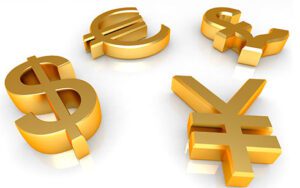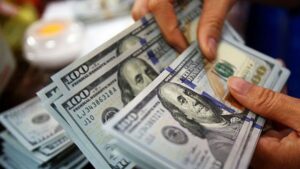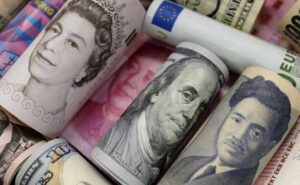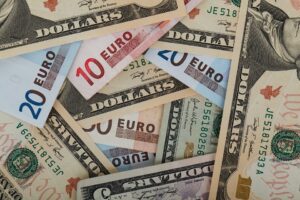
The US dollar is getting cheaper against the euro, the yen and the pound sterling in trading on Tuesday after the previous session’s strengthening following another Federal Reserve (Fed) statement.
This week, traders will focus on the Federal Reserve’s minutes of November 1-2 meeting at which the U.S. central bank raised its benchmark interest rate by 75 basis points (bps) and hinted at a possible slowdown in the rate hike.
The minutes of the meeting will be released Wednesday at 9 p.m. ET.
On Monday, Federal Reserve Bank (FRB) presidents Loretta Mester and Mary Daly of Cleveland and San Francisco signaled that the U.S. central bank would slow the pace of prime rate hikes next month, while stressing that the need for further policy tightening remains.
“I believe we can slow down the rate hike at the next meeting, I don’t see a problem with that,” Mester told CNBC. – However, I don’t think we’re close to pausing.”
For her part, Daley said the Fed should be mindful of the time lag between Fed decisions and their impact on the real economy. At the same time, she reiterated that she sees the need to raise the rate to at least 5%.
The ICE-calculated index showing the dollar’s performance against six currencies (euro, Swiss franc, yen, Canadian dollar, pound sterling and Swedish krona) lost 0.18% on Tuesday, while the broader WSJ Dollar lost 0.17%.
The euro/dollar pair is trading at $1.0259 as of 8:15 a.m., up from $1.0243 at the close of the previous session.
The dollar traded down to 141.78 yen from 142.14 yen on Monday.
The pound rate rose to $1.1851 compared to $1.1824 the day before.

The dollar is rising strongly against the euro and the pound sterling and moderately more expensive against the yen, thanks to increased demand for protective assets and hawkish statements from Fed chiefs.
The ICE-calculated index showing the dynamics of the US dollar against six currencies (euro, Swiss franc, yen, Canadian dollar, pound sterling and Swedish krona) is up 0.4%, while the broader WSJ Dollar Index is up 0.34%.
The euro/dollar pair is trading at $1.0284 by 7:35 a.m., versus $1.0326 at the close of last Friday’s session; the euro is losing about 0.4%.
The dollar/yen is up 0.1% at 140.47 yen, up from 140.39 yen at the end of last session.
The pound is getting cheaper by 0.5% and is trading at $1.1829 versus $1.1888 the day before.
Federal Reserve Bank of St. Louis Governor James Ballard said last week that the Fed would have to keep raising the benchmark interest rate. At the same time, the charts accompanying his remarks showed that its level could reach 5-7% per year.
Meanwhile, Boston Fed Chair Susan Collins said Friday that the Fed could consider various options for changing the interest rate at its December meeting, including a 75 basis point hike.
The Fed has raised the rate by 75 bps at its last four meetings, and now analysts and economists generally expect the next hike to be 50 bps.
The Fed will hold its next meeting on December 13-14.
The dollar is also supported by demand for safe haven assets amid fears over the spread of the coronavirus in China and actions by authorities to contain the pandemic, writes Trading Economics.

The dollar rises moderately against the euro and the pound sterling, but weakly depreciates against the yen as market participants assess statements by members of the U.S. Federal Reserve (Fed).
The ICE-calculated index showing the U.S. dollar against six currencies (euro, Swiss franc, yen, Canadian dollar, pound sterling and the Swedish krona) is up 0.16%, while the broader WSJ Dollar Index is up 0.14%.
The Fed will raise the benchmark interest rate by at least another 1 percentage point or more, and only after that could it take a pause, Mary Daley, head of the Federal Reserve Bank (FRB) of San Francisco, said the night before. A rate range of 4.75-5.25 percent “is a reasonable level to consider,” she told CNBC.
Kansas City Fed Governor Esther George also said the Fed should not stop raising rates too soon, and added that the goal of achieving a “soft landing” could be difficult.
The Fed has raised the benchmark interest rate by 3.75 percentage points (pp) in less than a year, increasing it by 0.75 pp at once in the last four meetings. The rate is currently at 3.75-4% per annum, and the market expects it to rise by 50 bps in December.
By 8:52 Moscow time the euro/dollar pair is trading at $1.0378 versus $1.0396 at the close of Wednesday’s session and the euro is losing about 0.2%.
The dollar/yen exchange rate is down 0.1% at 139.39 yen, down from 139.54 yen at the end of last session.
The pound is getting cheaper by 0.2% and trades at $1.1895 against $1.1915 the day before.
On Thursday the market is waiting for the final data on October inflation in the euro area and data on the construction of new houses in the USA.

The US dollar is getting cheaper against the euro and the pound sterling during the trading session on Tuesday.
The day before, the U.S. currency steadily strengthened on statements by Federal Reserve (Fed) officials that dampened investor optimism that the rate hike cycle may end soon.
Fed Vice Chair Lale Brainard told Bloomberg on Monday that the Fed is likely to slow the pace of rate hikes soon.
“However, I think it’s important to emphasize: we’ve done a lot already, but we still have more work to do,” Brainard said.
Earlier Monday, her colleague Christopher Waller, a member of the Fed’s board of governors, warned investors against overly optimistic about the timing of the end of the policy tightening cycle, noting that the Fed still has much work to do.
“We have a long, very long way to go to slow inflation. The rate will continue to rise, and it will stay high for a while, until we see it get closer to our target level,” Waller said at an event in Sydney hosted by UBS.
The ICE-calculated index, which shows the dollar’s performance against six currencies (euro, Swiss franc, yen, Canadian dollar, pound sterling and Swedish krona), added 0.2% on Tuesday, while the broader WSJ Dollar lost 0.03%.
The euro/dollar pair is trading at $1.0333 as of 9:15 a.m. Ksk, compared to $1.0329 at the close of the previous session. The pound rose to $1.1776, compared to $1.1760 the day before.
The dollar rose to 140.31 yen against 139.88 yen at the close of previous trading.
The exchange rate of the U.S. currency paired with the yuan dropped to 7.0491 yuan against 7.0740 yuan the day before. On Tuesday, the People’s Bank of China (PBOC, the country’s central bank) injected 850 billion yuan ($120.7 billion) into the financial system as part of its medium-term lending program (MLF).

The U.S. dollar is strengthening against the euro, yen and pound sterling in trading Tuesday.
The ICE-calculated index showing the dollar’s dynamics against six currencies (euro, Swiss franc, yen, Canadian dollar, pound sterling and Swedish krona) is adding 0.22%, while the broader WSJ Dollar is up 0.14%.
The euro/dollar pair is trading at $1.0007 as of 8:15 a.m., compared with $1.0022 at Monday’s market close.
The U.S. currency rose to 146.67 yen from 146.61 yen in the previous session.
The pound exchange rate fell to $1.1491 from $1.1514 the day before.
Traders’ attention this week is focused on the inflation data in the U.S. for October, which will be published by the Labor Department of the country on Thursday. Experts polled by FactSet are predicting, on average, a slowdown in U.S. consumer price growth to 8 percent year-over-year, down from 8.2 percent in September.
October U.S. inflation data will likely be a key factor in determining how much the Federal Reserve (Fed) will raise the benchmark rate at its December meeting.
Last Wednesday, the Fed raised rates by 75 basis points (bps) for the fourth consecutive meeting, to 3.75-4% per year, the highest since January 2008. U.S. Central Bank Chairman Jerome Powell said that the Fed could begin discussing a slowdown in the rate hike as early as the December meeting. At the same time, he stressed that it was too early to talk about stopping the cycle of rate hikes, and its limit will be higher than previously expected.
President of the Federal Reserve Bank (FRB) of Boston Susan Collins, speaking at the Brookings Institution, said that in December the Fed will discuss the possibility of another rate hike of 75 bps, as well as its less significant increase – 50 bps.

The US dollar is depreciating against the euro, yen and pound sterling in trading on Wednesday, the market awaits the results of a two-day meeting of the Federal Reserve System (Fed).
Traders have no doubt that the rate will be increased by 75 bp following the November meeting. for the fourth time in a row, and their focus is on statements by Fed Chairman Jerome Powell on the further pace of policy tightening.
Signals of persistent inflationary pressures require the US Central Bank to continue to raise rates, but some of its leaders have already made it clear that they consider it necessary to slow down the rate of increase and assess the economic consequences of earlier measures, The Wall Street Journal notes.
Many economists warn of the risks of the Fed tightening too much, which could trigger a severe economic downturn.
“The Fed will have to think about policy adjustments at the November meeting. They are trying to ‘cool’ the economy, not lead it to a deep freeze,” said KPMG chief economist Diane Swank, quoted by the WSJ.
Experts polled by Bloomberg expect the Fed to slow down the rate hike in December to 50 bp, after which it will raise it two more times by 25 bp. at the beginning of 2023.
The ICE-calculated index, which shows the dynamics of the dollar against six currencies (the euro, the Swiss franc, the yen, the Canadian dollar, the pound sterling and the Swedish krona), is losing 0.2% on Wednesday, the broader WSJ Dollar – 0.24%.
The euro/dollar pair is trading at $0.9893 at 9:00 AM, compared to $0.9874 at the market close on Tuesday.
The US dollar against the yen fell to 147.52 yen against 148.24 yen in the previous session.
The pound rose to $1.1510 from $1.1482 on Tuesday.
The Bank of England is also holding a meeting this week, its results will be made public on 3 November. Experts expect the British Central Bank to raise the base rate by 75 bp. – until 3%. The Bank of England did not raise the rate by more than 50 bp. since 1989, notes FT.